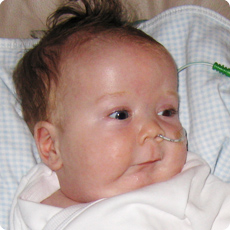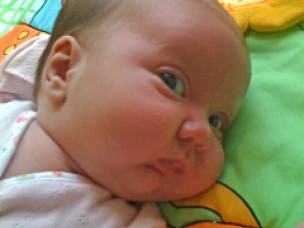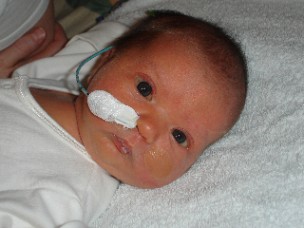
Pierre Robin Sequence
Around 50 babies are born with Pierre Robin Sequence ('PRS') in the UK every year.
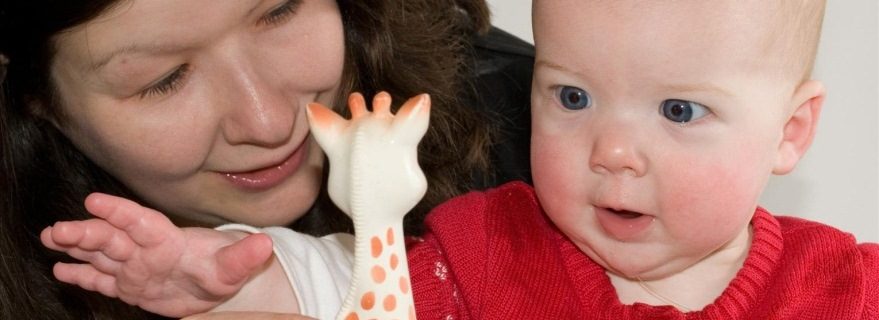
On This Page:
- What is it?
- How common is it?
- How does it happen?
- What does this mean for my child?
- How is it treated?
- Long term outcomes
- Talk to another parent
If there is anything you think is missing from this page, please let us know in the comments.
What is it?
Pierre Robin Sequence (PRS) is named after a French physician who identified the main features of the condition in the early 20th Century.
It is also occasionally called Pierre Robin Syndrome.
In medicine, a ‘sequence’ is when a number of issues occur in a particular order due to a single cause. Read more about how PRS happens.
The main features of PRS are as follows:
Small Lower Jaw
A baby with PRS will have a jaw which is noticeably smaller and more receded than those of other babies. This is called ‘mandibular hypoplasia’ or ‘micrognathia’. Below are three babies with this feature. Two also have nasogastric feeding tubes.
The smaller jaw is thought to be the cause of the other features of PRS, but because the jawbone continues to grow as children get older, it usually doesn’t need to be treated surgically.
Breathing difficulties
The smaller lower jaw means the baby’s tongue will be further back than usual. This means it is more likely to ball up and fall backwards into the throat, causing obstruction and therefore breathing difficulties. This is called ‘glossoptosis’. Breathing difficulties can be very difficult to manage and cause a lot of concern, so it’s important the baby is under the care (or at least under the supervision) of a specialist hospital.
Cleft Palate
A cleft palate (or a high arched palate without a cleft) may be present, and this can affect children in diffierent ways. Babies with a cleft palate often have issues with milk coming down their nose during bottle feeding, but this gets better as a feeding pattern is established, the child grows, and the palate is repaired.
A cleft palate (whether or not the child has Pierre Robin Sequence) can also cause hearing difficulties, so it’s important for your child’s hearing to be tested regularly. If you are under the care of a Cleft Team, this will happen automatically in the clinic. Otherwise, you will need to ask to see an ENT consultant or audiologist.
How common is it?
The condition is rare. Estimates range from 1 in 8,000 to 30,000 worldwide, and in the UK statistics put it at 1 in 14,500 babies, or just under 50 babies per year.
Around 50-80% of these babies have other associated conditions, with the most common being Stickler Syndrome.
How does it happen?
A ‘sequence’ is when a single issue in development results in a chain of other issues.
In both a ‘sequence‘ and a ‘syndrome‘, different symptoms and issues are grouped together into one condition, but with syndromes these issues don’t occur one after the other in the same way.
In the case of Pierre Robin Sequence, the main feature is a small lower jaw (‘mandibular hypoplasia’ or ‘micrognathia’), which leads to the tongue being more likely to fall backwards and obstruct the airways, which can then stop the palate from closing properly (causing a cleft palate). These issues can happen by themselves or be seen together.
It happens very early on in pregnancy, but we don’t know for sure why it happens. Research has looked into contracting a virus during pregnancy and folic acid deficiency as possible contributing factors, but nothing is known for sure. A ‘contributing factor’ increases the chance of something happening, it’s not the whole cause, and in most cases there will several contributing factors. The key thing to remember is that, much like a cleft lip and/or palate, it’s very unlikely to happen just because of something a parent did or didn’t do.
PRS can be a part of other syndromes/conditions with genetic links, such as Stickler Syndrome. It can be hard to diagnose PRS because of this.
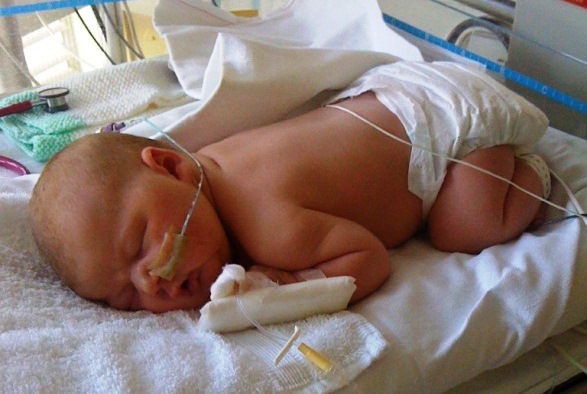
What does this mean for my child?
Most children with Pierre Robin Sequence grow up normally, even if they start their lives with quite severe problems.
All babies with Pierre Robin Sequence will have some difficulties, but these will vary from child to child.
Some have no problems with breathing and only minor feeding difficulties. These babies can usually go home shortly after birth.
Others have moderate difficulties, which may mean they have to stay in hospital until breathing and feeding patterns can be established. They may need to use a feeding tube (nasogastric or NG tube) for a while at home.
A smaller group of babies have major difficulties in both areas, and these can persist for several months and require the assistance of a nasal prong or even a tracheostomy. This can be very difficult for parents to cope with, so it’s important they get the right support and remember that these issues will improve as their child gets older.
All babies born with PRS need to be carefully investigated and monitored to make sure they can continue to take in enough oxygen. Parents need help and advice about the right feeding bottles and positions for feeding, which should again be given by experienced professionals. This help can come from a Cleft Team, a specialist health visitor, a speech and language therapist, a feeding clinic, or a combination of the above.
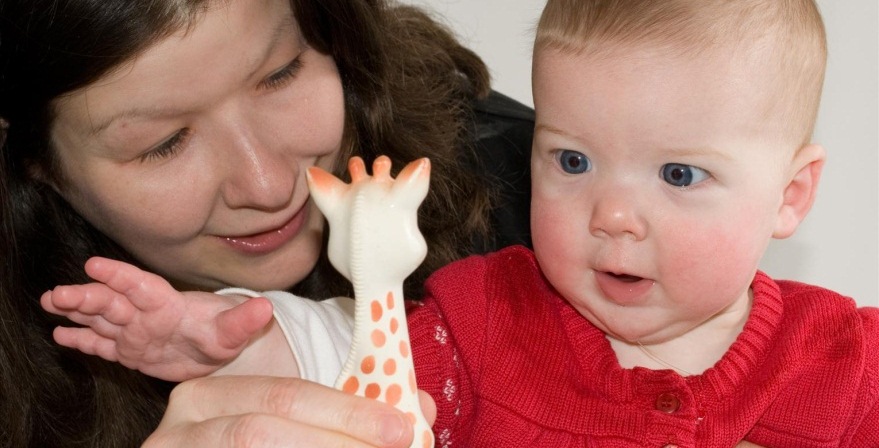
Important Points:
- Parents need individual expert advice and help with regard to feeding and positioning for both feeding and sleeping. This advice and help can only come from specialist health professionals. Advice for babies without Pierre Robin Sequence will not always be relevant and may in fact be harmful.
- Parents must be proactive and ensure that they are referred to all the relevant health professionals so their child can get the right care.
- Don’t forget that any new baby is tiring, and a baby with Pierre Robin requires a lot of extra attention. It is important to take some time for yourself. Try to get a break, look to family members or organisations such as Family Link who offer volunteers who are especially trained to look after children with special needs. Ask what, if any, provision that your local council offers such as short break care
- CLAPA has a number of Parent Supporters who have babies with Pierre Robin Sequence. They would be happy to talk to you about whatever you are going through, so please do get in touch with one if you need a listening ear.
How is it treated?
The jaw bone continues to grow during childhood and is usually fully grown by adulthood, so it’s the other elements of Pierre Robin Sequence – namely the breathing difficulties and cleft palate – that need to be managed.
It is vital that they get the care and supervision they need early on. This care should be provided by professionals who have experience of the condition, and it should be carried out (or at least coordinated from) a specialist hospital, especially during the first few weeks. Ideally, this should be an established Cleft Team which includes a specialist paediatrician. This arrangement is much better for parents and children because of the expertise within the team, and this way appointments can be arranged as one long visit rather than several visits to individual specialists.
If for whatever reason your child is not under the care of a Cleft Team, you will need to see the following specialists at some point: Otologist, Audiologist, Dietician, and a Specialist Health Visitor. You may need to ask for your child to be seen by these specialists. Do not assume that you will automatically be referred. As Stickler Syndrome is so common in babies with PRS, your baby must also be seen by an ophthalmologist for frequent eye checks. It’s best if you have a paediatrician who can look after all aspects of care, be alert for additional problems such as Stickler Syndrome, and refer you to various specialists when appropriate.
Seeing all these health professionals can be quite stressful for both parents and children. To make these experiences more positive and productive, try to make notes of points you wish to discuss and questions you’d like to ask, and make sure to ask for clarification if you don’t understand something that is being said.
If you are worried about something – speak up! You are around your baby constantly and know them better than the health professionals, so if you think something is wrong it’s best to be safe and mention it.
Feeding
All babies with Pierre Robin Sequence are assessed by a specialist nurse to establish the safest method of feeding. Some babies need more assistance than others due to reflux and breathing difficulties. An individual plan will be put into place for your child which may include a nasogastric (NG) tube, a thin tube which goes in through the nose and into the stomach. It’s the most common method of feeding babies who, for whatever reason, can’t get enough nutrition orally.
“Back home, we (I in particular) struggled with our new role as carers as well as parents. It was not the start to motherhood I had expected. One of the worst things was her feeding tube. We had a complicated relationship! I hated how I had to tape the tube to her face, how she screamed when it was put in and how it complicated her reflux. But I loved it as it kept my daughter alive. It often came out, which meant frequent trips to the children’s ward (often at night) so it could be put back in. A milestone for me was the day I learnt how to put her feeding tube in myself.”
Marianne Ryan
Not all babies with Pierre Robin Sequence need a nasogastric tube, and for those that do it’s usually gone by the time they are a year old.
Establishing feeding with a bottle takes time, patience and experimentation depending on the degree of your baby’s difficulties. This includes finding a bottle and a position which suits your baby. All babies should be offered bottle feeding as early as possible (along with tube feeding where necessary) to establish an association between sucking and receiving food. Hospitals should establish a good feeding pattern before any baby born with Pierre Robin Sequence is discharged home. Parents need expert advice and help from specialist feeding nurses, specialist health visitors and speech and language therapists to help them once the child is home.
Breathing and feeding can require a big effort for many babies with Pierre Robin Sequence, so weight gain can be slow. To help with loss of calories, supplements like Duocol can be added to feeds under the instruction of a dietician, or high calorie milk can be recommended. Most babies with a cleft palate suffer a lot with wind, and babies with PRS can gag and vomit easily, possibly due to the position of the tongue.
Feeding Equipment
There are various types of specialist bottles and teats only available from CLAPA. These can be purchased in our online shop or by phoning us on 020 7833 4883, Mon-Fri, 9-5.
The Haberman Feeder is a specialised bottle that was designed by a mother of a child that was born with Pierre Robin. It is designed to help any baby that has a weak sucking reflex. It is more expensive than other bottles but has been very successful for some babies whose degree of difficulty with sucking has been great. They are available from:
Athrodax Healthcare International Ltd
Hawthorne Business Park
Drybrook
Gloucestershire
GL17 9HP
Tel: 01594 544440
UK parents can get a reduced rate for this bottle as they can claim back the VAT. This exemption is because ‘your baby has a feeding difficulty’ and therefore this type of bottle has zero tax. On receipt of an order form, cheque and VAT form, Athrodax aim to send your order by return post. Credit card orders can be taken but they will be subject to VAT.
CLAPA holds a small emergency stock of complete Haberman bottles but we do not stock the replacement valves and teats, these will have to be purchased from Athrodax directly.
Weaning
It is often recommended that babies start on solid food, such as baby rice, at around four months because they find it easier to cope with food than with liquids. As with all babies, solid food should be pureed initially and lumps introduced very slowly to enable you baby to learn to cope with them, otherwise they may gag. It is important for you baby to experience chewing as it is thought to be a prerequisite for speech development. Teething rings may also be useful.
As always, discuss what is best with the health professionals looking after your baby. Whatever method is chosen, time, patience and a comfortable chair will be needed.
Breathing difficulties
Some babies with Pierre Robin Sequence have very few problems with breathing. However, it is generally advised that babies with PRS are nursed on the side or towards the front rather than on their back. This is contrary to the advice for most babies, but for babies with PRS it means their tongue is less likely to fall back and block their airways. Remember this is general advice only, and advice for your baby’s situation should always be sought from a specialist.
While travelling, it is recommended that your baby is positioned as upright as possible. If they need to lay on their side, they may need to travel in a carry cot. You can also buy special car seats for babies that lay flat and allow your baby to travel in a prone position. These are similar to carry cots and can be quite heavy, but can also be adapted to a pushchair.
Occasionally a small tube needs to be passed through the nose, behind the tongue, to improve breathing. This is called a nasopharyngeal airway or nasal prong.
In more severe cases, some surgeons sew the tongue to the lip as a temporary measure just to hold it forward. This is not done very often in the UK but is carried out quite widely in the USA.
Another option in severe cases is to actually lengthen the jaw by a technique known as mandibular distraction which gradually moves the jaw bones into a different position over time.
Finally, a very small number of babies with major problems with their breathing require tracheostomies, which is when an opening is created at the front of the neck so a tube can be inserted into the windpipe.
Sleeping
It is very difficult for a baby with Pierre Robin to lay on their back as this can cause their tongue to fall back and block their airway. The ‘correct’ sleeping position has become an issue in light of the Back to Sleep campaign to reduce cot death which advises babies sleep on their back and play on their front, but this does not apply to babies with Pierre Robin Sequence. The exact position for a baby with Pierre Robin depends on the severity of the breathing difficulties and how they are being managed; most babies are nursed on their side. Advice should be sought from a medical specialist who will take all the factors involved into consideration.
Surgery
If a cleft palate is present, repair can take place anytime between 6 and 19 months of age, depending both on the severity of the breathing difficulties and on the preferences of the surgeon.
There is a bit of a debate between Cleft Teams and individual surgeons about the best time to repair a cleft palate with Pierre Robin Sequence. The problem is that repairing the palate may temporarily make breathing worse. Some surgeons prefer to do the procedure at the usual time (from 6 months old) and accept that there may be some breathing issues which they may manage with a nasal prong until things get back to normal. Other surgeons prefer to wait for the jaw to grow in the hopes that breathing will naturally get better and therefore reduce the chances of further breathing problems after surgery.
Read more about cleft repair surgery.
The procedure will usually take between 1 ½ to 3 hours, depending on the extent of the cleft, and babies will usually stay in hospital for at least two days afterwards.
Feeding may take some time to be re-established after cleft palate repair but in most cases should be re-established in one to two weeks.
Because the clefts in babies with Pierre Robin Sequence tend to be very wide, it is very often necessary for relaxing cuts to be made on the side of the palate, but these heal very quickly. There is also an increased risk of developing a small hole in the repair. These holes sometimes heal by themselves, but sometimes a further small operation is needed.
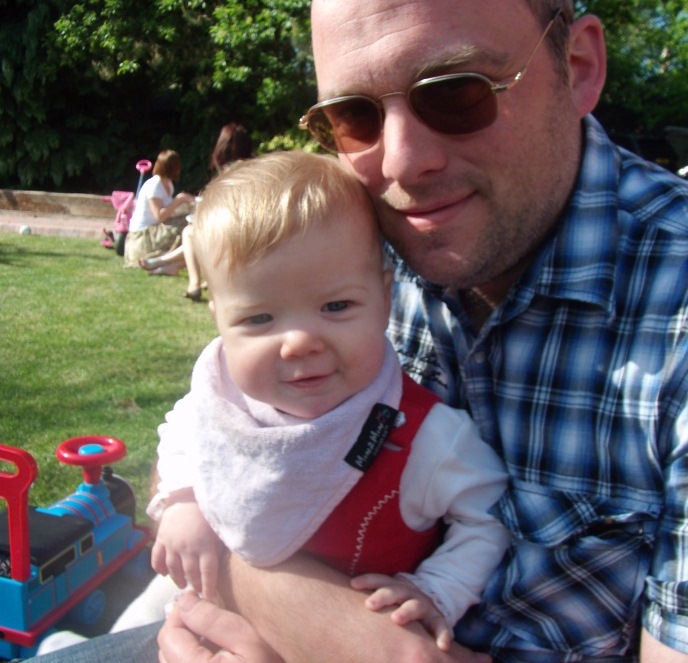
Long term outcomes
Most children with Pierre Robin Sequence grow up normally, even if they start their lives with quite severe problems.
In most cases, the chin will grow forward as the child gets older. The final position of the jaws has more to do with genetics than the Pierre Robin Sequence. The change is gradual, with improvement in the first year but continuing through childhood.
Need to Talk?
Several of our trained Parent Supporters have children who were born with Pierre Robin Sequence. If you need to talk to someone who understands just what you’re going through, get in touch today.
Read Parent Stories
CLAPA has a number of stories from parents of children with Pierre Robin Sequence about their child’s first year and beyond.
Chat on Facebook
Some parents affected by PRS have started an independent Facebook Group for mutual support and advice. This group is not run or moderated by CLAPA, but you may find it very helpful for more specific support.
